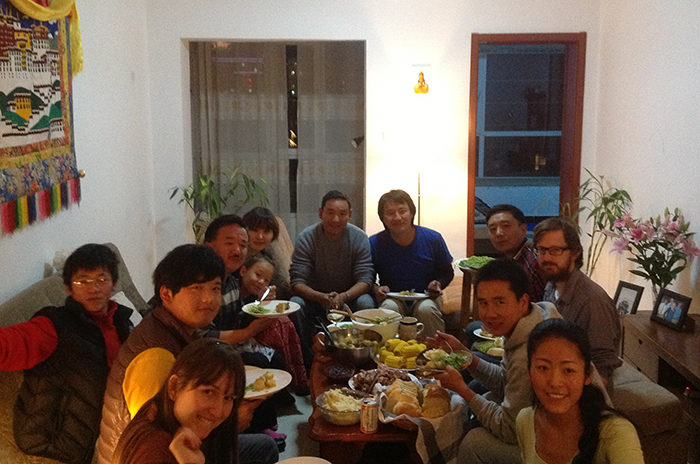ཟས་བྲོ་ཅན་ཡོད་ན་མགྲོན་ལ་བྱིན།
གཏམ་དོན་ཅན་ཡོད་ན་གཉེན་ལ་ཤོད།
“If you have delicious food, give it to your guest.
If you have important things to say, say it at a wedding.”
—Tibetan proverb
Thanksgiving has always been my favorite holiday. Though it is difficult to look past the holiday’s unsavory origins, the delectable food and coming together to give thanks for blessings has always appealed to me. So when I found myself on edges of the Tibetan Plateau in November 2011, I felt somewhat lost without my Turkey Day traditions. I could do without the tryptophan-induced football-watching couch-lock, but I missed being surrounded by family and friends.
Some of the expatriates in the Western Chinese city where I lived would gather at a local Peking duck restaurant to celebrate. We would invite a few local people, but the crowd was overwhelmingly American, leading to a curious observation: every time Americans outnumber in a group, we have a nasty habit of talking loudly about fantasy football, The Daily Show, American politics, or similar topics that exclude those of other backgrounds. Especially for the non-native English speakers, following these conversations is difficult and unenjoyable. My Tibetan friends felt alienated.
One year later, my wife and I started our own tradition: “Tibetsgiving.” We still attended the expat dinner, but we also celebrated our own version with a primarily Tibetan group of friends. We greeted them at the door in traditional Tibetan fashion with three cups of baijiu (a barley-based liquor popular in Western China) and plied them with a combination of Tibetan and “American” foods, washed down with Jim Beam and Budweiser.
For the American foods, we made mashed potatoes, salad, fresh bread, boxed stuffing, mashed yams, corn on the cob, and Rice Krispies treats. That haphazard collection of foods represents the limit of my non-breakfast culinary abilities. On the Tibetan side, we had Tibetan sha mo dumplings and yak meat, carrots, radishes, and potatoes cooked together in a pressure cooker, and more. We were also gifted one or two roast ducks each year, and we offered those to the group. Guests were encouraged to bring beverages of their choice, which often included juice, pop (I come from the Midwest, indulge me), and wine.
Over the course of the evening, conversations turned into laughter (and once a vigorous debate on the merits of borrowing terms from Chinese compared with the creation of Tibetan neologisms) and then to song. Song punctuates many a dinner on the Tibetan Plateau. To me it is the sign of a good dinner party. Songs ran the gamut from traditional Tibetan tunes to John Denver’s “Country Roads.”
This year, back in the United States, we shared Thanksgiving with family. I hadn’t seen some of them in over a decade. It was fun, but there was no singing. There was laughter, but also much talk of American celebrities like Taylor Swift. I savored the turkey and stuffing bread (this might be a local tradition), and reveled in the presence of family, the hospitality of my maternal relatives, but I also missed my friends on the plateau and thought of our past Tibetsgivings.
Tibetan food is often savory rather than sweet, understated but delicious. In many ways, it perfectly complements other Thanksgiving foods. Below, we have endeavored to recreate our staple: cooked yak meat, carrots, radishes, and potatoes.
Ingredients
2 pounds of yak meat (beef is an acceptable substitute; fatty meat is better)
1 large white radish
2 very large carrots
2 potatoes
Garlic, minced
Huajiao (Sichuan peppercorns)
Red chili peppers (optional)
Directions
1. Cut meat, radish, carrots, and potatoes into large cubes.
2. Put a small amount of oil in a pot on the stove. When the oil is warm (but not too hot, lest it burn the garlic), add garlic, hua jiao, and red chili peppers (if you prefer spicy food).
3. Add the meat. Brown the meat, and add salt and soy sauce to flavor and all the other foods and stir them together.
4. Once mixed, put it in a pressure cooker. For stovetop pressure cookers, cook at high pressure for three to five minutes, then turn off the heat and let sit. If you are using a rice cooker/pressure cooker combination device, try pressing the “fish” setting.*
5. After cooking, add cilantro and serve.
*A caveat: we have not made this food at low altitude. Best cooking practices may vary.
Tim Thurston is a postdoctoral fellow at the Center for Folklife and Cultural Heritage, where he works on programs dedicated to the preservation of Tibetan intangible cultural heritage. Between 2011 and 2015, he lived in Tibet conducting fieldwork for his dissertation on the social work of a wildly popular form of Tibetan comedy.


